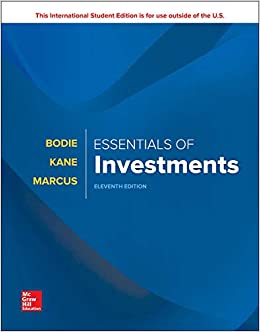Question
Provide full calculations and explanations for all questions 1. A company has an inventory period of 60 days, an accounts payable period of 30 days,
Provide full calculations and explanations for all questions
1. A company has an inventory period of 60 days, an accounts payable period of 30 days, and an accounts receivable period of 45 days. How long is the company's cash cycle? Generally speaking, how could this company decrease its cash cycle?
2. There are three types of secured inventory loans. Discuss the similarities and differences between them.
3. The Kappa Company has a beginning cash balance of $428 on February 1. The firm has projected sales of $550 in January, $700 in February, and $800 in March. The cost of goods sold is equal to 65% of sales. Goods are purchased one month prior to the month of sale. The accounts payable period is 30 days and the accounts receivable period is 15 days. The firm has monthly cash expenses of $200. What is the projected ending cash balance at the end of February? Assume that every month has 30 days.
4. Your supplier grants you credit terms of 2/10, net 35 (a 2.00% discount). What is the effective annual rate of the discount if you purchase $2,900 worth of merchandise?
5. Bernie's Active Adventure Co. receives an average of 10 cheques per day. The average amount per cheque is $2,400. Arnie is considering a new processing system that is expected to reduce the average collection time by 3 days. The daily interest rate on Treasury bills is .01 percent. What is the expected daily savings of the new system?
6. After a busy summer season the California Boat Company has a large cash balance, thanks to hot weather and brisk sales. The company's new CFO is considering investing the cash surplus in five-year high yield bonds currently being offered by another local company. The CEO has asked if these are junk bonds, and the CFO responded by saying that the high return could really help California Boat Company to be in a stronger cash position for next summer. What are the pros and cons of this strategy?
7. The GPK Corporation has asked for credit with your firm. GPK has not done business with your firm previously, but you have a strong feeling that if the first order goes well they will become a repeat customer. The company's purchasing manager would like to buy some equipment today at a cost of $425,000, with 30 days credit. Your variable cost for that equipment is $411,500 and your monthly interest rate is 1.25 percent. Your research shows that the probability of GPK defaulting is 5 percent. What is the net present value of this decision?
8.The Cheng Stone-Age Pottery Co. receives 50 cheques per month from customers. Average payments and clearing times are as follows: five cheques for $21,000, two days; 15 cheques for $58,000, three days; 25 cheques for $37,000, four days; and five cheques for $10,000, five days. Calculate the average daily float, assuming a 360-day year.
9. Rick, a new credit manager for the BZ company, told you that when BZ makes a credit decision, it always uses the customer's operating cycle as an upper limit for the credit period. Rick wonders if it might be a better idea to base these decisions on the customer's inventory period instead. How would you respond?
10. A web services company needs new equipment - recent loss of service issues have caused some key customers to switch to other providers.The cost of the equipment is $16,500,000.It is estimated that the firm will save $4,300,000 annually (after tax) for the next 5 years by installing the equipment. The firm is financed with 35% debt and 65% equity, based on market values.The firm's cost of equity is 9% and its after-tax cost of debt is 4.5%.The flotation costs of debt and equity are 3% and 5%, respectively.Assume the firm's tax rate is 30%.
a. What is the firm's WACC?
b. Ignoring flotation costs and using your answer from part (a) as the discount rate, what is the NPV of the proposed project?
c. What is the weighted average flotation cost, f, for the firm?
d. What is the dollar flotation cost of the proposed financing?
e. After considering flotation costs, what is the NPV of the proposed project?
Step by Step Solution
There are 3 Steps involved in it
Step: 1

Get Instant Access to Expert-Tailored Solutions
See step-by-step solutions with expert insights and AI powered tools for academic success
Step: 2

Step: 3

Ace Your Homework with AI
Get the answers you need in no time with our AI-driven, step-by-step assistance
Get Started


